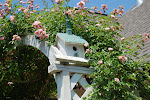Little girl was born to immigrants on 97 Orchard Street in 1901.
Baby Boy on the left and pretty little girl on the right pose for a portrait.
Notice the baby boy is dressed like the baby he is!!
We went to the tenement museum. You could choose from several different tours showing how different families lived. We chose the tour of a Jewish family who had a sewing business they ran in their family apartment.
This is an example of a tenement like 97 Orchard Street.
Did you know that the word tenement originally meant a house or dwelling occupied by three or more unrelated families. It was not a slum. In other words, just an apartment building. Early residents were lucky to have this roof over their heads and had to work hard to afford the rent of about $8 a month.
We marveled at the beauty of the tenements. The architectural details of the buildings were amazing. The beauty of the hallway woodwork and staircase was such that you would be challenged to find such workmanship today. The tour guide reminded us that the immigrants who came to this country brought with them many skills. So skilled labor was plentiful.
The building was built in 1863. During the civil war!! It was five stories tall.
The picture above shows two views of one floor of a building. You are looking at four separate apartments on the floor. Each apartment was about 300 square feet. A family with 6 or more children might live in one apartment.
(My sewing room is 300 square feet and it isn't big enough!!)
The left is the original floor plan shown in 1867 and the one on the right is 1905, after a set of building reforms was passed. The one on the right has an air shaft for the bedroom and they installed windows for circulation between the bedroom and kitchen and front room. Remember there was no electricity and windows only in the front room. It was hot (or cold) and dark. There was a stove in the kitchen but no other heat.
The only running water was one spigot for drinking that was down on ground level along with the four outhouses in the small yard to service the entire building. Imagine, going up and down the stairs with the water for every need. And four outhouses for an entire building!! You were carrying Chamber Pots up and down too.
The street in front of 97 Orchard Street on a normal day.
Home Sewing Business usually included 4 employees.
This is a picture of a family who had a home sewing business. From what I learned on the tour, the family who was featured borrowed money to purchase a sewing machine. The father would contract to sew for a Dress Company and agree to produce an unimaginable amount of garments in a week. The Dress Company would cut out the fabric and the father would send a runner to go get the cut out garments for him to sew.
Father had probably been a tailor in the old country and he ran the treadle sewing machine machine. He would have hired two young unmarried girls (teens) to baste the fabric together for him to sew. And he would have hired a man to press the garments. The presser stayed in the kitchen by the hot stove to keep his iron hot. They worked 10 or more hours a day to keep up with orders.
And don't forget the wife is tending the many children and running her house in the kitchen (which she is sharing with the presser) and the bedroom which barely held a double bed. And it was pointed out that she gave birth to at least one more child in their apartment while her husband had the home business - and they didn't stop production for childbirth.
Children were used as runners to take the cut fabric and finished garments back and forth from Dress Company to Home Sewing businesses. If you look closely at the picture above this one, of the street outside 97 Orchard St., you will see another child carrying a load of garments.
This story had a happy ending. The family worked hard, did with out and saved up money enough to move out of the area. I think to Brooklyn. They started another business and purchased a house.
I love happy endings!!
All Designs Are Copyright Protected copyright 2010 Jeannie Baumeister




























































































5 comments:
I have been enjoying your trip to NYC vicariously. I have been to Ellis Island, too, but I'd love to see the tenement museum you visited. Those are the types of apartments my great-grandparents lived in. Thanks for sharing your photos and stories!
What a wonderful post you created for us to see the past and the garment district. The clothes, so perfect, no wonder we all strive to recreate them.
I'm really enjoying your trip. I find the history fascinating. Especially since it has to do with sewing.
I've been told my great grandfather was a tailor that come over from Poland and, most likely, came through Ellis Island also.
Absolutely loved this history lesson. My father's parents came from Russia, through Ellis Island, so I have an appreciation for your trip. Great stuff.
Jeannie,
This is such an interesting series of posts. I mentioned my grandmother and mother came through Ellis Island, and so did my grandmother's brothers, who with her, were all in the tailoring business.
Post a Comment